In This Issue:
Did someone forward this email to you? Subscribe now -- it's free!
A Celebration of Waterfowl and Wetland Conservation
As we collectively marvel at the influx of waterfowl into Texas each year, there are many of us who are equally taken aback by the journey which brought them here. To think about the millions of birds taking to the skies each day, the thousands of miles covered in search of food and safe harbor, and how vital a role our wetlands, playas, and refuges play in sustaining that legacy of flight. As we welcome a new member to the Small Game Program team this year, dive into the complexities of goose migrations, and celebrate the 30th anniversary of the North American Wetland Conservation Act, we acknowledge that none of this could have been accomplished without the support and trust of you, our dedicated constituents and partners. Thank you all for making waterfowl a priority now and for decades to come. Here’s to another 30 years!
Sincerely, Small Game Program Team
New Wetland Program Leader - Welcome Dr. Rachel Fern!
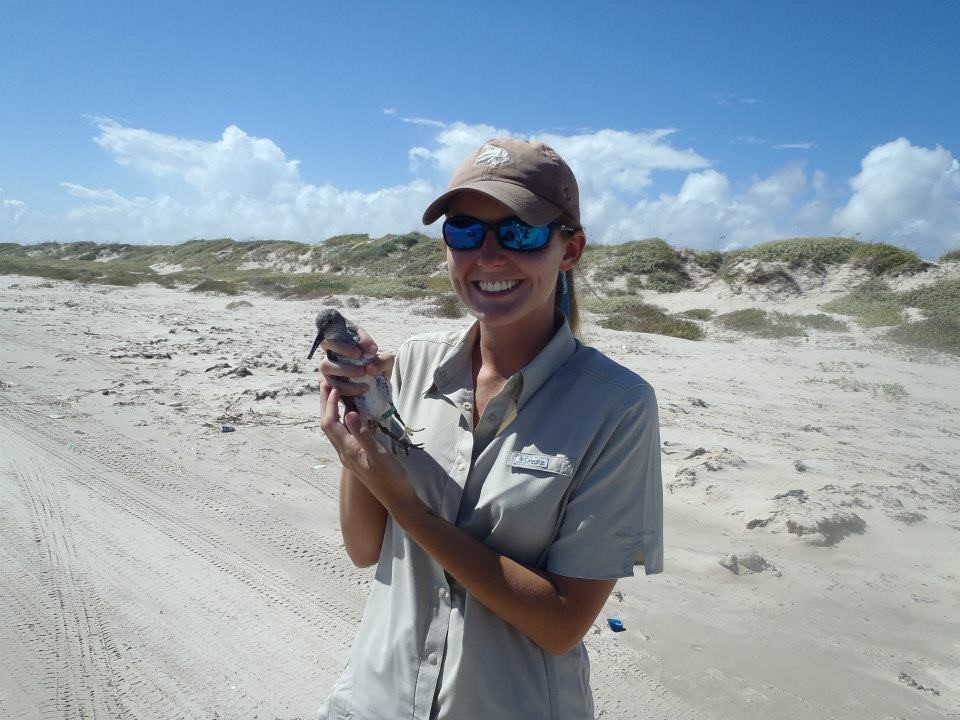 Dr. Rachel Fern, Statewide Wetland Program Leader, with a red knot at Padre Island National Seashore, TX.
This past November we welcomed Dr. Rachel Fern to the TPWD family. She joins the Small Game Program as the new Statewide Wetland Program Leader and will be responsible for the administration of a wide range of wetland habitat projects benefiting migratory birds. In her own words, Rachel, “recognizes the centrality and importance of healthy wetland systems to migratory game bird populations,” and it is our hope to utilize her unique skills and experiences to complement a robust community of researchers and managers in Texas.
Most recently, Rachel finished a post-doctoral appointment as a Research Geographer with the U.S. Geological Survey, Northern Prairie Wildlife Research Center in North Dakota. There, her work focused on researching and communicating the important benefits of healthy, functioning wetlands to the future of the Prairie Pothole Region, its wildlife, and its people. Previously, Rachel earned a B.S. in Wildlife Ecology from Texas State University (2011), an M.S. in Marine Biology (2013) from Texas A&M University-Corpus Christi, and a PhD in Wildlife and Fisheries Science from Texas A&M University (2018).
Importantly, Rachel brings a host of diverse knowledge and expertise from her previous positions. Whether studying the toxic effects of chemical pollution along the Gulf of Mexico, documenting avian migration patterns throughout the central U.S., investigating waterbird nesting behavior in the Florida Everglades, or working with advanced imagery and models to inform agricultural and rangeland management decisions in Texas, her commitment to and passion for our natural resources is evident. We are excited to welcome Rachel to the agency and believe her personal character and biological background make her a strong addition to our team.
If you would like to contact Dr. Fern or have questions about Texas’ wetlands, you can reach her at rachel.fern@tpwd.texas.gov. Rachel is based out of San Marcos.
National Dove Wingbee - Missouri
Every November, biologists and volunteers from across the country head to Lee’s Summit, Missouri for the annual Dove Wingbee. More formally known as the U.S. Fish & Wildlife Service’s (USFWS) Parts Collection Survey, the Wingbee is used to obtain detailed information about harvested migratory game birds, namely waterfowl, dove, and woodcock. The USFWS asks a sample of hunters across the U.S. to send in a wing from each bird they shoot; these wings help provide estimates of species, age, and sex composition of harvested migratory birds. On average, the small group of 10-15 biologists process around 10,000 dove wings at the Dove Wingbee annually. This year was no exception, and, after 2 days locked in a room breathing feather dander and listening to bad jokes, the group was thrilled to get out for some clean air and afternoon sunshine!
For more information on the survey and how the data is used, check out the USFWS' Migratory Bird Program page online.
By: Owen Fitzsimmons, Webless Migratory Game Bird Program Leader
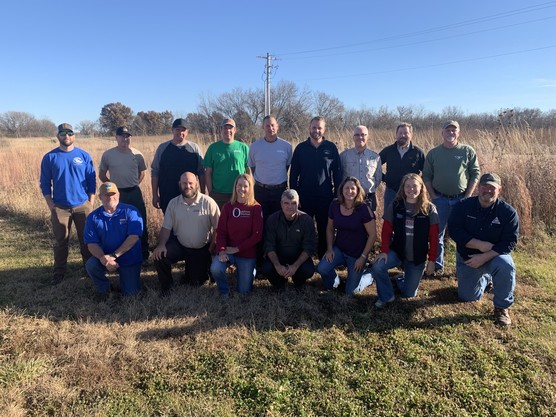 Biologists from USFWS, Texas, Missouri, Kentucky, Kansas, Arizona, Ohio, Delaware, Louisiana, and Oklahoma at the Dove Wingbee - November 2019, Lee’s Summit, MO.
Hunting - Dove Season Update
“Welcome to Texas, where the forecasts are made up and the seasons don’t matter!”
September 2019 was the hottest September on record in Texas. This is coming off the 4th wettest September on record in 2018, and Hurricane Harvey in 2017. By now, Texas dove hunters should have mud boots, sunblock, and a warm coat in the truck to be prepared for anything! Despite the heat this year, the opening week of North and Central Zone hunting was good and dove fields across the state were in prime condition thanks to a mild, wet spring. Unfortunately, most of the state didn’t see a cold front until the 2nd week of October, so hunting was spotty early on. Those that went out later, however, had some great hunts in October and November by timing the fronts. South Zone regular season hunting, on the other hand, was on fire from opening day with numerous reports of great hunting throughout September and October. As I’m writing this, hunters are still targeting good groups of late-season birds in January. Harvest estimates won’t be available until well after the season ends, but after two years of below-average harvest estimates, 2019 overall dove harvest will likely push back into the average range.
By: Owen Fitzsimmons, Webless Migratory Game Bird Program Leader
Hunting - Quail Season Update
While there are certainly exceptions, the 2019-20 quail hunting season won’t be anything to write home about. Although there have been reports of pockets of good quail hunting in the Trans-Pecos, South Texas, and parts of the Panhandle, many the state’s quail hunts have been met with a murmur. As was detailed in our fall forecast, low reproductive stock (number of hens available to breed) and hot, dry conditions throughout the summer last year put a damper on our recovery from the drought cycle in 2017. However, this boom and bust cycle is normal for quail and while hunting has been slow, populations across the state did trend slightly upward in 2019; given we continue to experience mild winter conditions and receive sufficient rainfall this spring, 2020 could pull us out of the slump.
Below we detail our Wildlife Management Area (WMA) hunt numbers as of January 10th. Most WMAs are experiencing average to below average hunt conditions. A special thank you to all our WMA staff who provided updates and insights into their respective areas; in the trenches, they are the front line when it comes to conserving and protecting TPWDs public lands. Check out our Annual Public Hunting 2019-2020 page for more information on places to get out and chase quail before the season ends.
By: John McLaughlin, West Texas Quail Program Leader
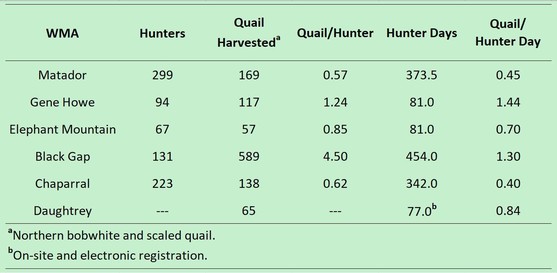 Quail Hunters and Harvest at TPWD Wildlife Management Areas (WMA), 26 October 2019 – 10 January 2020.
Tracking Greater White-Fronted Geese Across Texas and North America
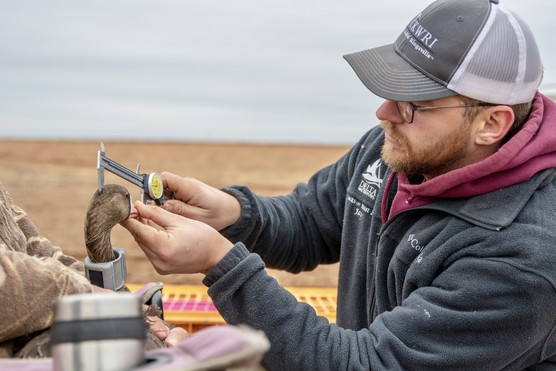 Jay VonBank, Texas A&M University-Kingsville, works up a greater white-fronted goose as part of his research.
Greater white-fronted geese, commonly referred to as “specklebellies”, were once abundant throughout the Gulf Coastal regions of Texas. Over the last 20 years TPWD goose surveys, flown annually to count the number of geese wintering in Texas, showed that geese were becoming less abundant along the Gulf while numbers were growing to the north, particularly in Arkansas. To investigate this issue TPWD partnered with Texas A&M University-Kingsville, the University of Missouri, and Louisiana Department of Wildlife and Fisheries to determine when, where, and why geese move throughout their annual cycle. Since 2015, over 120 GPS tracking devices have been attached to white-fronts throughout Texas and Louisiana to investigate movements, behaviors, and energy expenditure during the winter period, to understand how long white-fronts spend each winter in different regions, and to learn about migration timing, routes, and stopovers during spring and fall migrations. Advanced transmitters allow researchers to get an accurate GPS location every 30 minutes and determine specific behaviors of geese, such as feeding, walking, or flying, every six minutes around the clock. To date, nearly 1 million GPS locations and tens of millions of behavior measurements have been collected to help understand the drivers of white-front movements.
White-fronts breed primarily in the arctic tundra of Canada and northern Alaska, and in the boreal forest of Interior Alaska. Nearly 70% of all white-fronts captured during winter subsequently bred on the Alaskan North Slope, or in Western and Nunavut, Canada. Additionally, individuals captured in each wintering region summered in several different breeding regions, indicating that the entire Midcontinent population intermingles on their southern wintering grounds. During winter, white-fronts make extensive movements throughout their wintering range from Arkansas, through Louisiana and Texas, as far south as Mexico, and do so much more frequently than previously known. Most of these movements occur early during the winter period, primarily in December when white-fronts move the farthest distance each day. This information is valuable to both harvest and habitat managers because we now know that despite the large concentrations of white-fronts shifting northward, a large portion (>50% during some winters) of tagged white-fronts continue to use several regions in Texas each year. In some regions (e.g., Rolling Plains) white-fronts return regularly, and continue to use each winter, where the duration of their stay can exceed 120 days...
 GPS locations (pink dots) from over 100 greater white-fronted geese captured in Texas and Louisiana, 2016-2019.
...Understanding how white-fronts use and move about their winter landscape will help us understand the drivers of this large-scale distribution shift during winter and how we can better manage for white-fronts which remain in Texas. White-front capture and tracking will continue into 2020, aiming to deploy more tracking devices to continue to monitor geese in the future.
By: Jay VonBank, Doctoral Candidate, Texas A&M-Kingsville, Contributing Author
Wild Turkey Restoration and Restocking in East Texas
The wild turkey was once numerous in east Texas. However, due to rapid, human induced changes in habitat and unregulated harvest, wild turkeys were extirpated from east Texas around the turn of the 20th century. Early attempts at restoration utilized pen reared turkeys and in the mid-1980s TPWD began releasing wild trapped eastern wild turkeys from numerous states across the southeast and mid-west. By 2003, over 7,000 wild turkeys had been restocked into east Texas utilizing a block stocking approach. This stocking method called for the release of 15-20 birds released per site with 5-10 release sites per county. These restoration efforts were successful in several areas, but many more failed to create sustainable populations. Today, Texas has an open spring turkey season in 13 east Texas counties.
TPWD funded research through Stephen F. Austin State University in 2007 to test a super stocking model for restoring turkey populations. This model called for the release of 80+ wild turkeys per site, which was 4 times the number of birds released following the block stocking method. In total, 320 wild turkeys were restocked at 4 sites in Anderson, Houston, Montgomery, Nacogdoches counties. After 3 years of research, this method demonstrated considerable merit with survival and recruitment similar to states with established populations. Today, the Anderson County release site supports some of the highest densities of wild turkeys in east Texas...
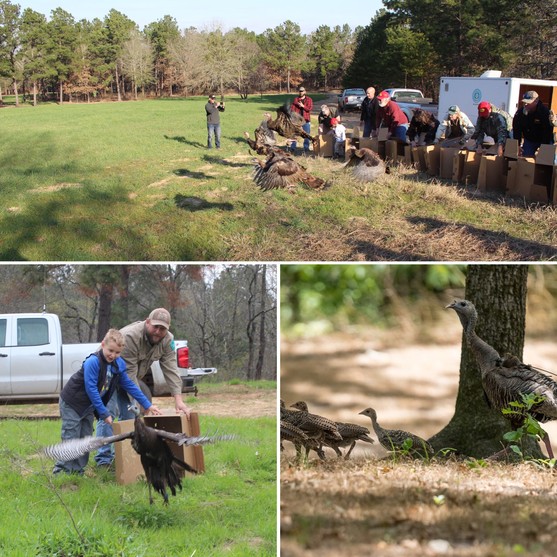 Top: Volunteers release wild turkeys from their holding boxes; Bottom Left: Jason Hardin, TPWD Wild Turkey Program Leader, and son release turkey from holding box; Bottom Right: A hen with GPS backpack follows her young poults through the forest.
...In 2014, TPWD reopened the Wild Turkey Restoration Program in east Texas. Over the past 7 years TPWD has released over 1,100 wild turkeys at 12 sites in east Texas including both the eastern and Rio Grande wild turkey subspecies with Rios only released in the Trinity River watershed. With partner and public support, we hope to fully restore healthy, sustainable populations of wild turkeys into the region...
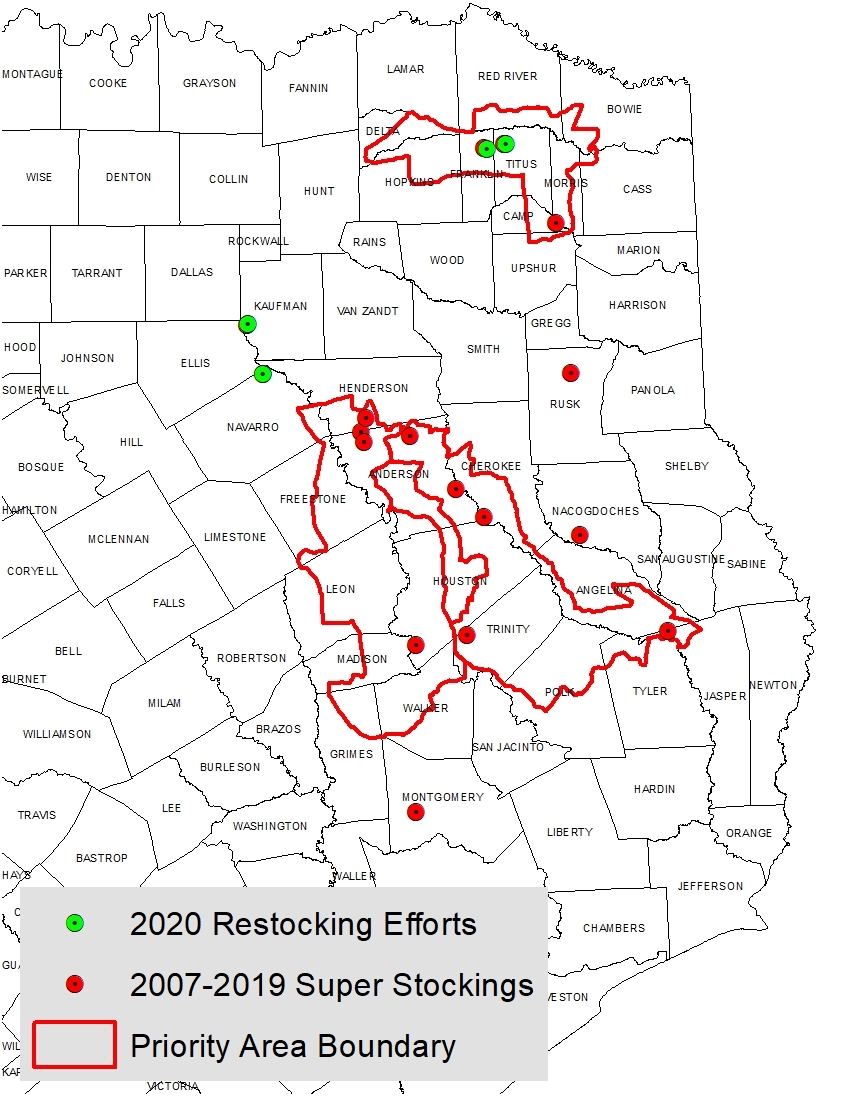 TPWD east Texas wild turkey restocking efforts and priority areas, 2007-2020.
...Today, TPWD is focusing restoration efforts in three Priority Areas. These priority areas include the Neches River Priority Area (Neches River and White Rock Creek watersheds within Anderson, Angelina, Cherokee, Houston, Jasper, Polk, Trinity, and Tyler Counties), the Sulphur River Priority Area (Sulphur River, White Oak Creek, and Cypress Creek watersheds within Bowie, Camp, Cass, Delta, Franklin, Hopkins, Morris, Red River, Titus, and Upshur Counties), and the Trinity River Priority Area (Anderson, Freestone, Grimes, Henderson, Houston, Leon, Madison, Navarro, Trinity and Walker Counties). If you are interested in the program and would like more information, landowners can reach out to TPWD’s Wild Turkey Program Leader, Jason Hardin, at jason.hardin@tpwd.texas.gov.
Minimum Qualifications: proposed release sites must consist of a minimum of 10,000 acres of contiguous usable habitat and can consist of multiple landowners. Those proposed sites consisting of multiple landowners must demonstrate a level of cooperation among landowner members.
By: Jason Hardin, Wild Turkey Program Leader
The Coastal Grassland Restoration Inventive Program (C-GRIP)
Since 1971, the population of northern bobwhites and mottled ducks in Texas has decreased dramatically. There are many factors that contribute to these population declines, but the primary cause is the loss of available suitable habitat needed to sustain these species. Conversion of native grasses to introduced pasture, overgrazing, suppression of fire, and brush encroachment have all had a significant impact on the ability of Texas grasslands to provide for the needs of northern bobwhite and mottled duck, as well as other grassland species. To address these drastic population declines, it is crucial that private landowners are encouraged and supported in their efforts to improve habitat for these grassland birds on the lands they own and manage.
C-GRIP provides financial incentives to private landowners for conducting habitat treatments that address the greatest limiting factors for suitability of grassland bird habitat on their property. The Grassland Restoration Incentive Program was first implemented in 2013 by the Oaks and Prairies Joint Venture in portions of Texas and Oklahoma. In 2018, the Gulf Coast Joint Venture (GCJV) implemented C-GRIP in the central section of coastal Texas. Modeled after the Natural Resource Conservation Service's Environmental Quality Incentive Program and other similar programs, C-GRIP is a voluntary program that reimburses private landowners a set payment rate for identified practices that generally fall into the categories of brush management, prescribed burning, native grass reseeding, and prescribed grazing.
From 1 September 2018 to 30 August 2019 C-GRIP has received 17 project applications for funding and funded 12 of those projects. During the first year of C-GRIP, $214,574.32 was spent enrolling 10,306 acres, resulting in a cost of about $42.00 per acre; the most utilized funded management practices include brush management, fire breaks, and disking. We are anticipating another great enrollment in C-GRIP for 2020.
The involvement of multiple partners is a hallmark of successful conservation programs; C-GRIP follows that model. C-GRIP partners have the opportunity to contribute to this important program that delivers grassland habitat outlined in several of the GCJV’s planning documents (visit the GCJV website for more information). Partners can contribute in a variety of ways to make C-GRIP successful...
 Current C-GRIP partners and the respective roles they play in the C-GRIP program.
 Gulf Coast Joint Ventures' C-GRIP focal areas.
...GCJV currently has $55,500 available for projects and is accepting C-GRIP applications, so be sure to check your eligibility and review the proposal submission process and instructions to see if you qualify!
For more information about C-GRIP visit www.cgrip.org. If you have any questions, please e-mail Steve DeMaso at steve_demaso@fws.gov, or call (337) 266-8812 for assistance.
By: Steve DeMaso, GCJV Monitoring and C-GRIP Coordinator, Contributing Author
Celebrating 30 Years of Wetland Conservation Success
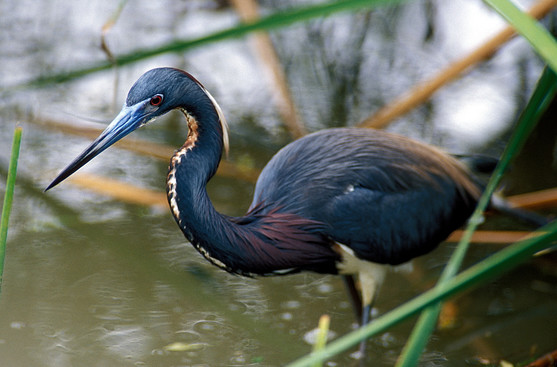 Tri-colored heron, Texas Parks and Wildlife Department.
In December 1989, President George H.W. Bush signed into law the North American Wetland Conservation Act (NAWCA), which was a new continental conservation funding mechanism. Designed to assist the North American Waterfowl Management Plan when waterfowl populations were declining across North America, NAWCA has also benefited many wildlife species and people across the continent.
Since its inception, nearly 2,950 NAWCA projects have utilized more than $1.7 billion in federal funds which leveraged $3.6 billion in matching funds and another $1.4 billion in nonmatching funds from nearly 6,200 partners across North America. The first NAWCA grant allocated to Texas was awarded to The Nature Conservancy in 1991 to assist with the development of the Clive Runnells Family Mad Island Marsh Preserve in Matagorda County.
Subsequently, various federal, state, and non-profit partners, including Ducks Unlimited, Katy Prairie Conservancy, The Conservation Fund, the Texas Parks and Wildlife Department, Texas R.I.C.E., and the U.S. Fish & Wildlife Service have received financial funding to conduct wetland restoration and acquisition across Texas for the benefit of wildlife populations.
This month, we celebrate the 30th anniversary of this successful program across North America. Although not well known amongst the public, this federal program has allowed Texans to expand their hunting, fishing, hiking, birding, and other recreational opportunities across Texas. In addition, this program brings partners together across regions for a common goal: conservation. As waterfowl populations have recovered, wetlands remain an important part of our landscape that increases flood resiliency and water quality while providing critical habitat for wildlife populations across Texas.
Adapted from TPWD News Release, December 20, 2019
Lost - 3 Billion Birds
This article originally appeared in the TPW Magazine, Jan-Feb 2020.
 Photo: Mac Stone; Courtesy: National Audubon Society, 2020
In September 2019, the journal Science announced the loss of billions of birds over the past half-century in North America, and the news spread fast, reaching a new generation of concerned citizens. For conservationists, the information wasn’t new, but rather a painful reminder that we need to make conservation a priority.
What caught the public’s attention was the authors’ quantification of the decline -- approximately 3 billion birds in 50 years, a staggering number. These declines are due to a multitude of threats and dangers, including collisions with windows and encounters with free-ranging house cats, but none more noteworthy than the conversion of habitat to human uses.
The longest, steepest decline can be found in our nation's grassland birds, the result of a global decline in natural plant communities (bird habitats). Stated simply, humans have destroyed important habitats that birds and other critters call home.
In Val Lehmann’s 1941 monograph Attwater's Prairie Chicken: Its Life History and Management, he observed that, by 1937, the original 6 million acres of prairie habitat in Texas and southwest Louisiana suitable for Attwater's prairie chickens had been drained, leveled and converted, leaving less than a half-million acres of suitable prairie habitat. The result? Prairie chicken numbers dropped from 1 million to only 8,700 -- half of which were in just two Texas counties...
 A male Attwater's Prairie-Chicken booms next to a hen at Attwater's Prairie Chicken National Wildlife Refuge near Eagle Lake, TX - Credit: Noppadol Paothong, Courtesy: National Audubon Society, 2020.
...Prairie habitats also support other grassland birds whose numbers have plummeted, like the northern bobwhite, eastern meadowlark, loggerhead shrike, Henslow’s sparrow, Sprague’s pipit and northern harrier. Prairies are also crucial for many types of waterfowl and numerous other plants and animals.
The most important way to shift the tide of bird loss is to restore native habitats. Protecting open space, utilizing thoughtful urban development, planting backyard native wildscapes, controlling invasive species and converting pastures back to native grasses are ways to accomplish this goal.
One new hope on the horizon is Restoring America’s Wildlife Act. Passage would mean more than $50 million in new funds each year for Texas wildlife, transforming efforts to conserve and restore more than 1,300 species of concern in Texas, the majority of which are at-risk, non-game fish and wildlife. Learn more about this once-in-a-lifetime opportunity to protect our wildlife!
By: Cliff Shackelford, State Ornithologist, Contributing Author
America's Wildlife Values: The Social Context of Wildlife Management in the United States
An excerpt:
Conflict is increasingly common in contemporary fish and wildlife management. The source of conflict is typically not a matter of biology; rather, it involves a clash of goals among stakeholders. To many in the wildlife profession, conflict among stakeholders appears to be intensifying over time.
The purpose of the America's Wildlife Values Project was to assess the social context of wildlife management in the U.S. in an attempt to understand this conflict. It is the first-ever study that describes how U.S. residents across all states, and within each state separately, think about wildlife. The project provides insight into the mix of values that publics have toward wildlife, how this mix of values contributes to conflict over policy issues, and how changing societal conditions are affecting wildlife management across the country. The study also assesses the culture of state fish and wildlife agencies and, when combined with the public assessment, allows us to explore the dynamics between agency culture and public values.
The full report is now available for the public.
 Manfredo et al. 2018. America's Wildlife Values: The Social Context of Wildlife Management in the U.S. National report from the research project entitled "America's Wildlife Values". Fort Collins, CO; Colorado State University, Department of Human Dimensions of Natural Resources.
Feb. 13-15: Texas Chapter of The Wildlife Society: Annual Meeting (Corpus Christi, TX)
Mar. 8-13: 85th North American Wildlife and Natural Resources Conference (Omaha, NE)
Head over to OutdoorAnnual.com for all season dates and license requirements!
|